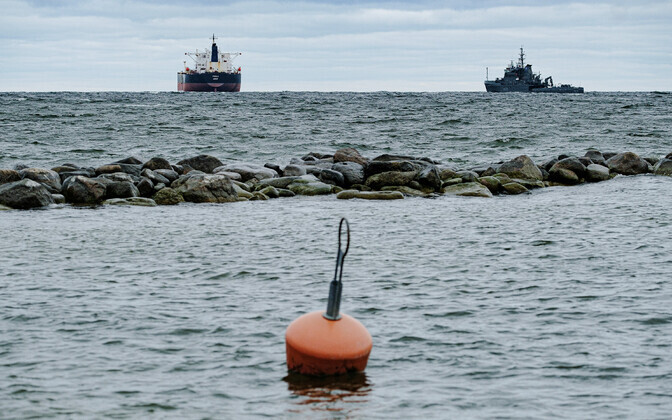According to the report compiled by the EDF Intelligence Center, there are currently around a dozen flagless tankers operating in the seas of northwestern Europe. At the same time, several officials who spoke anonymously to ERR admitted Estonia has already largely exhausted its options for preventing the use of shadow fleet vessels and broader international action is now needed.
The EDF Intelligence Center’s report shows that Russia’s full-scale invasion of Ukraine began in 2022, the Baltic Sea has become a key trade route for Moscow. Currently, at least 60 percent of Russian oil and oil products exported by sea pass through the Baltic. This has increased by nearly 40 percent since March 2022, and the shadow fleet now accounts for 20 percent of Russian maritime transport.
Restricting the movement of shadow fleet tankers in the Baltic Sea would contribute to reducing Russia’s revenues and, alongside that, its military capabilities – both in Ukraine and more broadly. In addition, keeping shadow fleet tankers that are often in poor condition out of the Baltic Sea would also reduce the risk of environmental accidents. The damage from a significant incident of that type would far exceed the cost of the damage caused to undersea cables and pipes that has occurred so far, according to the report. This is all the more important given that vessels in the shadow fleet often lack sufficient insurance coverage.
However, another threat related to Russia’s shadow fleet has also recently emerged. Ships with dubious backgrounds that may be participating in security incidents in coastal countries, including the recent mysterious drone flights in Denmark and Germany, which are linked to the tanker Boracay having been detained off the coast of France last weekend. Suspicions have also been raised in Poland and Germany that ships from the shadow fleet operating in the Baltic Sea have been engaged in reconnaissance activities there.
Major pollution incident could cost billions
In addition to the military security aspect, also of major concern is the risk of environmental damage caused by the poor condition of the ships in Russia’s shadow fleet and the lack of competence common among many of their crews.
Valdur Lahtvee, senior project manager at the Stockholm Environment Institute (SEI) in Tallinn, who has received training in marine pollution response from the Swedish Coast Guard, told ERR that according to some risk assessments, there could be 3-5 pollutuion-related accidents in the region over the next ten years.
Athough Estonia and its neighboring countries are prepared for pollution control, a major tanker accident could still cause billions of euros in damage. It would also destroy the Baltic Sea ecosystem, which is recognized as a particularly sensitive marine environment and includes the seabirds and beaches that are important to those who visit the region.
Lahtvee pointed out that, according to estimates by the International Tanker Owners Pollution Federation (ITOPF), the cost of pollution damage ranges from $600 to $4,000 per barrel (one barrel is approximately 120 liters ), meaning that the direct damage could amount to $30,000 per ton of oil product spilled into the water.
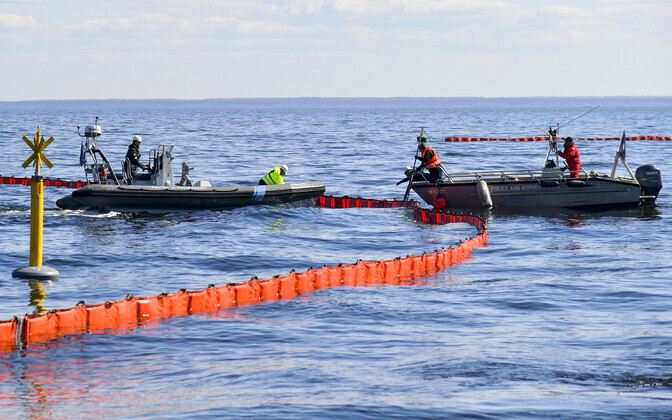 Cleanup of pollution near Toila in Narva Bay. Source: Sergei Stepanov/ERR
Cleanup of pollution near Toila in Narva Bay. Source: Sergei Stepanov/ERR
It is known that tankers loading oil products from the Russian ports of Ust-Luga and Primorsk have a capacity of around 100,000 tons. According to Lahtvee, approximately 200 tankers sail in the Baltic Sea every month. Data from the Estonian Defense Forces (EDF) Intelligence Center show that currently around 20 tankers from the shadow fleet pass through the Baltic Sea per month.
Lahtvee also recalled one of Estonia’s largest incidences of marine pollution, when 250 tons of crude oil leaked from the Greek tanker Alambra in the port of Muuga in 2000. The damage caused totaled an estimated 370 million Estonian Kroons at the time (Approximately €23.67 million in today’s currency – ed.), though Estonia ultimately received only around 6 or 7 million Kroons through the courts.
Coastal states still have options for pressuring shadow fleet
An official familiar with the matter told ERR that coastal states do have some options for controlling vessels passing through their territory. The offical, who spoke anonymously, pointed out that Estonia began requesting insurance documents from vessels in the Finnish Gulf last summer, a move that certainly caused the vessels some inconvenience.
The possibilities available to coastal states were also emphasized by maritime law expert Alexander Lott.
“According to the U.S. Navy’s handbook on maritime operations, any coastal state may stop a ship outside its territorial waters, as France has now done in the case of Pushpa (better known as Boracay – ed.), if the ship’s alleged flag state rejects or fails to confirm its nationality in a positive and unambiguous manner,” Lott told ERR, referring to a tanker from the shadow fleet detained off the coast of France this week.
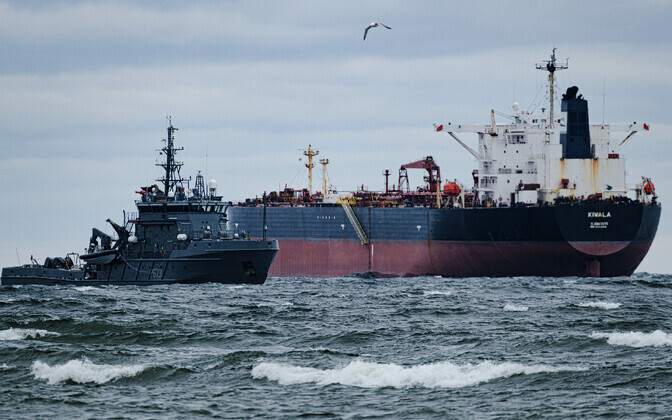 The Kiwala detained off the Estonian coast between the island of Aegna and the port of Muuga, east of Tallinn, Friday, April 11, 2025. Source: Priit Mürk/ERR
The Kiwala detained off the Estonian coast between the island of Aegna and the port of Muuga, east of Tallinn, Friday, April 11, 2025. Source: Priit Mürk/ERR
“Although Pushpa claims to be sailing under the flag of Benin, this is not the decisive factor in determining the nationality of the ship. This is also supported by case law.
In the Enrica Lexie incident between Italy and India in 2012, the Annex VII Arbitral Tribunal found that: “The criterion for determining the jurisdictional link between a ship and a state under the Convention is whether the ship has the nationality of that state, not whether it is registered in a public registry or flies the flag of that state. The flag may therefore be considered as ‘visual evidence’ or a ‘symbol’ of nationality, but it is not a decisive factor in determining the nationality of a ship.”
The intelligence center also noted in its review that Article 110 of the UN Convention on the Law of the Sea provides coastal states with the right to stop and board ships on the high seas if there is reason to believe that they have no nationality, i.e., they lack a valid national flag.
This was also supported by the French public prosecutor’s office after the oil tanker Boracay was detained in the economic zone near France’s east coast, but not in its territorial waters.
Restrictions affecting the shadow fleet
According to the aforementioned official, it is noticeable how carefully Russia has tried to toe the line in the Baltic Sea. This suggests it does not want to take too many risks in getting into undue difficulties here. On the other hand, Russia considers the Baltic Sea to be its own and is therefore very sensitive to any restrictions on its activities here, he added. He believes Russia would “go crazy” if Denmark were to close its shipping channels, for instance.
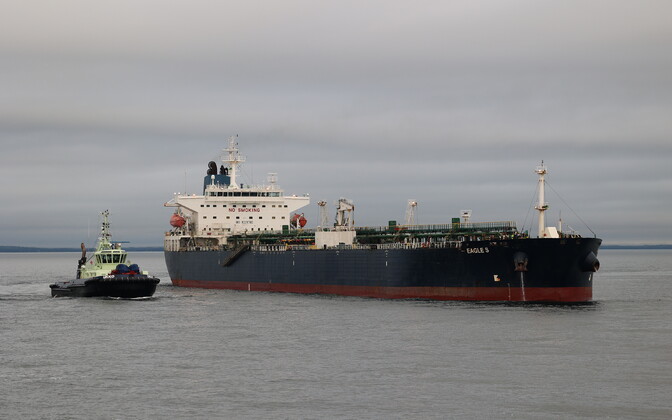 Patrol boat escorting the Eagle S tanker. Source: Finnish Border Guard
Patrol boat escorting the Eagle S tanker. Source: Finnish Border Guard
However, more widespread inspections of suspicious vessels would also send a message to the owners of other Russian shadow fleet ships. Their activities would become more complicated and costly, which would also have a clear impact Russian oil shipments, noted an official who spoke to ERR anonymously.
If ship owners can see that their tankers may be detained, required to rectify various deficiencies, or subjected to other time-consuming activities, they may refuse to offer their services to Russian oil exporters or demand higher prices for their work. Either way, this would reduce Russia’s ability to earn revenue from oil exports.
International cooperation needed
Another government official told ERR that combating the shadow fleet is a constant battle to plug new legal loopholes the Russian oil tankers find and seek to exploit. “Everything that can be done under our domestic law has already been done, and now we need to find international options that are in line with maritime law,” the official said.
The intelligence center emphasized the same point in its overview: “In order to restrict the activities of the tanker fleet in the Baltic Sea, all countries bordering the Baltic Sea that have the right and obligation to control what happens in their waters must contribute actively. /—/ Restricting the shadow fleet in the Baltic Sea has stalled due to the inability of countries to agree on proportionate countermeasures and their enforcement. The reasons are likely to be both practical and political in nature, compounded by conflicting economic interests among countries.”
At the same time, Estonia, along with 11 other countries bordering the Baltic and North Sea, began cooperation at the expert level last year to discuss joint steps to combat Russia’s shadow flee. However, as of last December, only Estonia and the U.K. had begun to request insurance documents from suspected Russian shadow fleet vessels operating in their economic waters, a representative of the Estonian Ministry of Foreign Affairs said at the time.
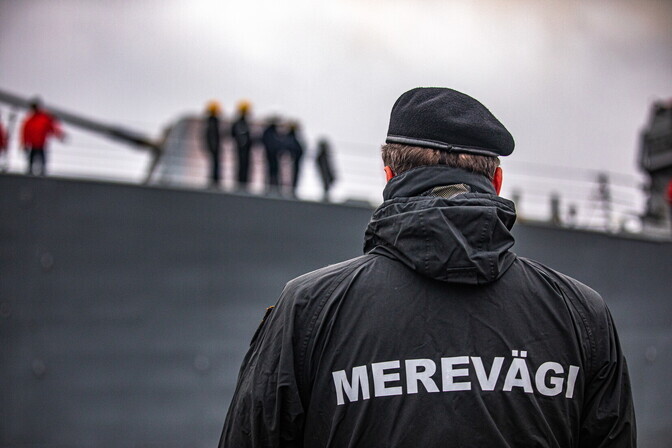 Estonian Navy member looking on as the USS Roosevelt, an Arleigh Burke-class US Navy destroyer, arrives in Tallinn earlier this year (photo is illustrative). Source: mil.ee
Estonian Navy member looking on as the USS Roosevelt, an Arleigh Burke-class US Navy destroyer, arrives in Tallinn earlier this year (photo is illustrative). Source: mil.ee
Since then, interest in this type of cooperation as well as Estonia’s experience in dealing with the shadwo fleet, have both grown, said the first official.
“Our interest is for these matters to be dealt with as far away from Russia as possible – in the North Sea or the Mediterranean,” he said, noting that France and Belgium have allegedly inspected ships from the shadow fleet, but have done so without much fanfare.
“We do not want to be the police of the Baltic Sea, nor can we be, as we do not have the resources for this and do not want the escalation that would accompany it,” the official said.
Estonia’s expectations seem to align with the statement made by French President Emmanuel Macron statement this week. Macron said a new plan is being prepared in the EU to turn off Russia’s financial taps, which would also include restricting the activities of its shadow fleet. According to Macron, Russia’s shadow fleet consists of 800-1,000 vessels.
According to data from think tank CEPA, as of July, the European Union had recognized 444 vessels as part of the shadow fleet. However, with the 19th package of sanctions currently under discussion, another 118 vessels should be added to that list.
The EDF Intelligence Center believes that identifying and sanctioning the additional shadow fleet ships and applying secondary sanctions from the EU on countries that register those sanctioned vessels sanctions, would be one way to limit the activities of the shadow fleet.
—
